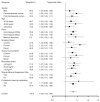Serum selenium and serum lipids in US adults
- PMID: 18689378
- PMCID: PMC2553708
- DOI: 10.1093/ajcn/88.2.416
Serum selenium and serum lipids in US adults
Abstract
Background: Selenium, an essential micronutrient, has received considerable attention for its antioxidant properties. In addition, selenium may affect several cardiometabolic risk factors, such as glucose homeostasis and lipid concentrations. However, the effects of selenium intake on the lipid profile in selenium-replete populations, such as the United States, are largely unknown.
Objective: We examined the relation of serum selenium concentrations with serum lipids in a representative sample of US adults.
Design: This was a cross-sectional analysis of 5452 men and women aged >/= 20 y participating in the third National Health and Nutrition Examination survey. Serum selenium was measured by atomic absorption spectrometry.
Results: The multivariable adjusted differences in total cholesterol, LDL cholesterol, HDL cholesterol, apolipoprotein B (apo B), and apolipoprotein A-I (apo A-I) comparing the highest with the lowest quartile of serum selenium were 16.6 mg/dL (95% CI: 11.6, 21.4 mg/dL), 10.9 mg/dL (95% CI: 6.4, 15.4 mg/dL), 3.2 mg/dL (95% CI: 1.6, 5.0 mg/dL), 8.9 mg/dL (95% CI: 5.6, 12.2 mg/dL), and 6.9 mg/dL (95% CI: 1.7, 12.1 mg/dL), respectively. Participants in the highest quartile of serum selenium had 10% higher concentrations of triacylglycerols than did participants in the lowest quartile (ratio of triacylglycerol concentrations: 1.10; 95% CI: 1.05, 1.17). The difference in the ratios of LDL cholesterol to HDL cholesterol and apo B to apo A-I that compared the highest with the lowest selenium quartiles were 0.11 (95% CI: -0.02, 0.25) and 0.03 (95% CI: 0.00, 0.06), respectively.
Conclusion: Elevated serum selenium was associated with elevated serum concentrations of total cholesterol, LDL cholesterol, HDL cholesterol, triacylglycerols, apo B, and apo A-I among US adults, a selenium-replete population. Experimental studies are needed to determine cause and effect relations and the potential mechanisms underlying these associations.
Figures



References
-
- Rayman MP. The importance of selenium to human health. Lancet. 2000;356:233–41. - PubMed
-
- Navas-Acien A, Bleys J, Guallar E. Selenium intake and cardiovascular risk: what is new? Curr Opin Lipidol. 2008;19:43–9. - PubMed
-
- Food and Nutrition Board, Institute of Medicine . A report of the Panel on Dietary Antioxidants and Related Compounds, Subcommittees on Upper Reference Levels of Nutrients and Interpretation and Uses of Dietary Reference Intakes, and the Standing Committee on the Scientific Evaluation of Dietary Reference Intakes. National Academy Press; Washington, DC: 2000. Dietary reference in-takes for vitamin C, vitamin E, selenium, and carotenoids.
-
- Dhingra S, Bansal MP. Hypercholesterolemia and LDL receptor mRNA expression: modulation by selenium supplementation. Biometals. 2006;19:493–501. - PubMed
-
- Dhingra S, Bansal MP. Modulation of hypercholesterolemia-induced alterations in apolipoprotein B and HMG-CoA reductase expression by selenium supplementation. Chem Biol Interact. 2006;161:49–56. - PubMed
Publication types
MeSH terms
Substances
Grants and funding
LinkOut - more resources
Full Text Sources
Medical

